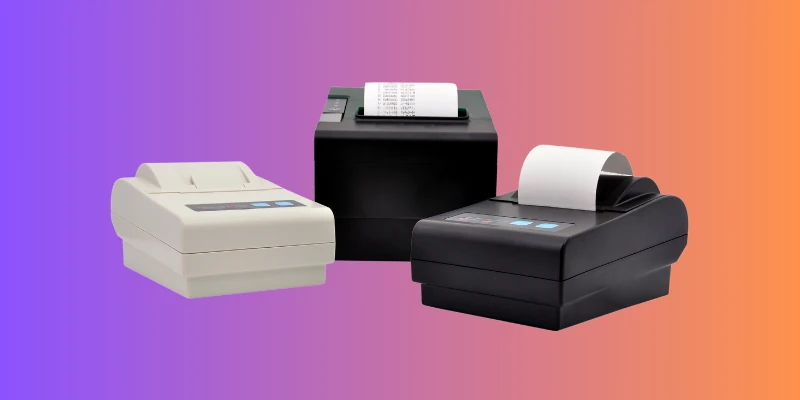Thermal Printers Quick Silent Prints for Work and Home
Published: 19 Apr 2025
Did you know thermal printers don’t need ink or toner? Instead, they use heat to create crisp, clear prints in seconds! That’s why they’re a go-to choice for businesses printing receipts, labels, and barcodes. With fewer moving parts, they’re faster, quieter, and easier to maintain than traditional printers. But how exactly do they work? Let’s get information about thermal printers:
Introduction
A thermal printer is a type of printer that uses heat to create images on paper instead of ink or toner. It works by applying heat to special heat-sensitive paper (direct thermal) or using a ribbon to transfer ink (thermal transfer). These Printers are widely used for receipts, shipping labels, barcodes, and tickets due to their speed, efficiency, and low maintenance.
Importance of Thermal Printers?
- Fast Printing: Produces receipts and labels instantly, improving efficiency.
- Cost-Effective: No ink or toner required, reducing ongoing expenses.
- Low Maintenance: Fewer moving parts mean fewer breakdowns and repairs.
- Business Essential: Used in retail, logistics, healthcare, and hospitality.
- Quiet Operation: Works without loud noises, ideal for customer-facing areas.
- Durable Prints: Thermal transfer prints last longer and resist smudging.

Types of Thermal Printers
- Direct Thermal Printer: Uses heat-sensitive paper to print without ink or ribbon, but prints fade over time.
- Thermal Transfer Printer: Uses a ribbon to transfer ink onto paper, creating long-lasting, high-quality prints.
- Mobile Thermal Printer: Compact and portable, used for receipts and labels on the go.
- Industrial Thermal Printer: Heavy-duty printer for high-volume label printing in warehouses and factories.
- Desktop Thermal Printer: Small and space-saving, ideal for retail and office use.
Applications of Thermal Printers
Retail: Prints receipts quickly at checkout counters.
- Logistics & Shipping: Creates shipping labels and barcodes for packages.
- Healthcare: Prints patient wristbands, prescription labels, and medical records.
- Hospitality: Generates hotel bills, food order tickets, and event passes.
- Manufacturing: Produces durable labels for product packaging and tracking.
- Banking & ATMs: Prints transaction receipts and account slips.
- Warehousing: Labels inventory for easy tracking and stock management.
- Government & ID Cards: Prints voter ID cards, visitor badges, and parking tickets.
- Field Services: Used in mobile invoicing and on-the-go printing for businesses.
| Advantages of thermal printers |
|---|
|
| Disadvantages of thermal printers |
|---|
|
Thermal printers are commonly used for printing receipts, shipping labels, barcodes, and tickets. They are fast, reliable, and don’t require ink or toner. Businesses use them because they are low-maintenance and cost-effective.
A thermal printer uses heat to create images on special paper. Direct thermal printers print directly on heat-sensitive paper, while thermal transfer printers use a ribbon to transfer ink. This makes them faster and more efficient than regular inkjet or laser printers.
No, thermal printers don’t use ink or toner. They rely on heat to print, which means fewer expenses and less mess. However, thermal transfer printers use a ribbon that contains ink for long-lasting prints.
Direct thermal printing uses heat-sensitive paper and doesn’t require ink or ribbon, but the prints fade over time. Thermal transfer printing uses a ribbon and creates durable, long-lasting prints. If you need receipts, go with direct thermal; for labels or barcodes, thermal transfer is better.
Direct thermal prints fade because they react to heat, light, and chemicals. Over time, the paper darkens, making the text harder to read. This is why they’re best for short-term use, like receipts and shipping labels.
Most thermal printers only print in black, but some specialized ones can print in red or blue. Thermal transfer printers can print in different colors if you use colored ribbons. However, for full-color printing, an inkjet or laser printer is a better choice.
Thermal printers have an affordable upfront cost, and they save money in the long run because they don’t need ink or toner. The main expense is the special thermal paper or ribbons. Overall, they are cost-effective for businesses with high printing needs.
No, thermal printers require special heat-sensitive paper or ribbon to print. Regular paper won’t react to the heat, so nothing will appear on it. Always check the type of paper your printer needs before using it.
No, thermal printers are low-maintenance compared to inkjet or laser printers. You only need to clean the printhead occasionally and replace the paper or ribbon when needed. This makes them a great choice for businesses that need hassle-free printing.
If you print a lot of shipping labels, barcodes, or receipts, a thermal printer can be a great investment. However, for regular documents or colorful prints, an inkjet or laser printer might be a better option. Think about your needs before deciding!
Conclusion
So guys, in this article, we’ve covered thermal printers in detail. If you’re tired of dealing with ink cartridges and slow printing, a thermal printer might be just what you need! I’d personally suggest a direct thermal printer for quick and hassle-free printing or a thermal transfer printer if you need durable prints. Take your time to choose the right one for your needs. Have questions or need help deciding? Drop a comment below, I’d love to help!

- Be Respectful
- Stay Relevant
- Stay Positive
- True Feedback
- Encourage Discussion
- Avoid Spamming
- No Fake News
- Don't Copy-Paste
- No Personal Attacks

- Be Respectful
- Stay Relevant
- Stay Positive
- True Feedback
- Encourage Discussion
- Avoid Spamming
- No Fake News
- Don't Copy-Paste
- No Personal Attacks
